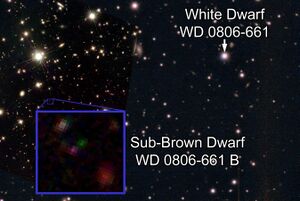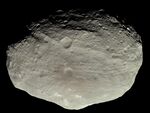Astronomy:WD 0806−661
Coordinates: ![]() 08h 06m 53.736s, −66° 18′ 16.74″
08h 06m 53.736s, −66° 18′ 16.74″
 The right side shows an image taken by ESO's VLT HAWK-I in near-infrared. The white dwarf is marked with an arrow. The left side shows an image taken by the NASA/ESA HST WFC3 also in near-infrared wavelengths. The sub-brown dwarf appears as green pixels (2014) and purple pixels (2015) in an insert. | |
| Observation data Equinox J2000.0]] (ICRS) | |
|---|---|
| Constellation | Volans |
| Right ascension | 08h 06m 53.75366s[2] |
| Declination | −66° 18′ 16.7011″[2] |
| Characteristics | |
| Spectral type | DQ4.2[3][4] + Y1[5] |
| Apparent magnitude (B) | 13.74[6] / - |
| Apparent magnitude (V) | 13.71[6] / - |
| Apparent magnitude (R) | 13.64[6] / - |
| Apparent magnitude (I) | 13.60[6] / - |
| Apparent magnitude (J) | 13.704 ± 0.023[1] / ~25.42[7] |
| Apparent magnitude (H) | 13.739 ± 0.025[1] / ~25.29[7] |
| Apparent magnitude (K) | 13.781 ± 0.043[1] / - |
| Astrometry | |
| Proper motion (μ) | RA: 335.519(16)[2] mas/yr Dec.: −288.994(17)[2] mas/yr |
| Parallax (π) | 51.9970 ± 0.0141[2] mas |
| Distance | 62.73 ± 0.02 ly (19.232 ± 0.005 pc) |
| Absolute magnitude (MV) | 12.30[6] / - |
| Details | |
| Component A | |
| Mass | 0.58 ± 0.03[6] M☉ |
| Surface gravity (log g) | 8.00 ± 0.05[6] cgs |
| Temperature | 10205 ± 390[6] K |
| Age | 1.5–2.7[7] Gyr |
| Component B | |
| Mass | 7–9[7] MJup |
| Surface gravity (log g) | 4.2–4.3[7] cgs |
| Temperature | 325–350[7] K |
| Metallicity | <0[7] |
| Position (relative to A) | |
| Component | B |
| Angular distance | 130.2 ± 0.2″ [8] |
| Position angle | 104.2 ± 0.2° [8] |
| Observed separation (projected) | 2500 AU [8] |
| Other designations | |
| Database references | |
| SIMBAD | data |
| Extrasolar Planets Encyclopaedia | data |
WD 0806−661 (L 97-3, GJ 3483), formally named Maru,[9] is a DQ white dwarf with an extremely cold Y-type substellar companion (designated "B"), located in the constellation Volans at 62.7 light-years (19.2 parsecs) from Earth. The companion was discovered in 2011, and is the only known Y-type companion to a star or stellar remnant. At the time of its discovery WD 0806-661 B had the largest actual (2500 AU) and apparent separation (more than 2 arcminutes) of any known planetary-mass object, as well as being the coldest directly imaged substellar object then known.
WD 0806-661 B
Component WD 0806-661 B was discovered in 2011 with the Spitzer Space Telescope. Its discovery paper is Luhman et al., 2011. The secondary has a mass between 7 and 9 |♃|J}}}}}} and a temperature between 325–350 Kelvin (52-77 °C; 125-170 °F).[7] At the time of its discovery, WD 0806−661 B was the coldest "brown dwarf" that has ever been found.[8] The object is too faint to acquire a spectrum even with the Hubble Space Telescope, however the spectral type of this object was estimated to be Y1 based on its detection in Hubble images at near-infrared wavelengths.[5] The photometric colors of this object suggest that it is metal-poor. The metal-poor composition of the companion could explain the DQ spectral type of the primary white dwarf.[7] Hydrogen-deficient AGB stars might evolve into DB white dwarfs and then into DQ white dwarfs as they cool down.[10]
In August 2022, WD 0806-661 and its planetary-mass companion were included among 20 systems to be named by the third NameExoWorlds project.[11] The approved names, proposed by a team from South Korea , were announced in June 2023. WD 0806-661 is named Maru and its companion is named Ahra, after Korean words meaning "sky" and "ocean".[9]
See also
- WISE 0146+4234 – a Y0 companion to a T9 brown dwarf
- WISE 1217+1626 B – another Y0 companion to a T9 brown dwarf
- DT Virginis
- HD 106906 b
- GU Piscium b
References
- ↑ 1.0 1.1 1.2 1.3 1.4 "GJ 3483 -- White Dwarf". SIMBAD. Centre de données astronomiques de Strasbourg. http://simbad.u-strasbg.fr/simbad/sim-id?protocol=html&Ident=GJ+3483.
- ↑ 2.0 2.1 2.2 2.3 Vallenari, A. et al. (2022). "Gaia Data Release 3. Summary of the content and survey properties". Astronomy & Astrophysics. doi:10.1051/0004-6361/202243940 Gaia DR3 record for this source at VizieR.
- ↑ Holberg, J. B.; Sion, E. M.; Oswalt, T.; McCook, G. P.; Foran, S.; Subasavage, John P. (2008). "A New Look at the Local White Dwarf Population". The Astronomical Journal 135 (4): 1225–1238. doi:10.1088/0004-6256/135/4/1225. Bibcode: 2008AJ....135.1225H. https://commons.erau.edu/cgi/viewcontent.cgi?article=1948&context=publication.
- ↑ Sion, Edward M.; Holberg, J. B.; Oswalt, Terry D.; McCook, George P.; Wasatonic, Richard (2009). "The White Dwarfs Within 20 Parsecs of the Sun: Kinematics and Statistics". The Astronomical Journal 138 (6): 1681–1689. doi:10.1088/0004-6256/138/6/1681. Bibcode: 2009AJ....138.1681S.
- ↑ 5.0 5.1 Leggett, S. K.; Morley, Caroline V.; Marley, M. S.; Saumon, D. (January 2015). "Near-infrared Photometry of Y Dwarfs: Low Ammonia Abundance and the Onset of Water Clouds" (in en). The Astrophysical Journal 799 (1): 37. doi:10.1088/0004-637X/799/1/37. ISSN 0004-637X. Bibcode: 2015ApJ...799...37L.
- ↑ 6.0 6.1 6.2 6.3 6.4 6.5 6.6 6.7 Giammichele, N.; Bergeron, P.; Dufour, P. (2012). "Know Your Neighborhood: A Detailed Model Atmosphere Analysis of Nearby White Dwarfs". The Astrophysical Journal Supplement 199 (2): 29. doi:10.1088/0067-0049/199/2/29. Bibcode: 2012ApJS..199...29G.
- ↑ 7.0 7.1 7.2 7.3 7.4 7.5 7.6 7.7 7.8 Leggett, S. K.; Tremblin, P.; Esplin, T. L.; Luhman, K. L.; Morley, Caroline V. (June 2017). "The Y-type Brown Dwarfs: Estimates of Mass and Age from New Astrometry, Homogenized Photometry, and Near-infrared Spectroscopy" (in en). The Astrophysical Journal 842 (2): 118. doi:10.3847/1538-4357/aa6fb5. ISSN 0004-637X. Bibcode: 2017ApJ...842..118L.
- ↑ 8.0 8.1 8.2 8.3 Luhman, K. L.; Burgasser, Adam J.; Bochanski, J. J. (2011). "Discovery of a Candidate for the Coolest Known Brown Dwarf". The Astrophysical Journal Letters 730 (1): L9. doi:10.1088/2041-8205/730/1/L9. Bibcode: 2011ApJ...730L...9L.
- ↑ 9.0 9.1 "2022 Approved Names". IAU. https://www.nameexoworlds.iau.org/2022approved-names.
- ↑ Althaus, L. G.; Serenelli, A. M.; Panei, J. A.; Córsico, A. H.; García-Berro, E.; Scóccola, C. G. (May 2005). "The formation and evolution of hydrogen-deficient post-AGB white dwarfs: The emerging chemical profile and the expectations for the PG 1159-DB-DQ evolutionary connection" (in en). Astronomy and Astrophysics 435 (2): 631–648. doi:10.1051/0004-6361:20041965. ISSN 0004-6361. Bibcode: 2005A&A...435..631A.
- ↑ "List of ExoWorlds 2022". IAU. 8 August 2022. https://www.nameexoworlds.iau.org/2022exoworlds.
External links
 |




